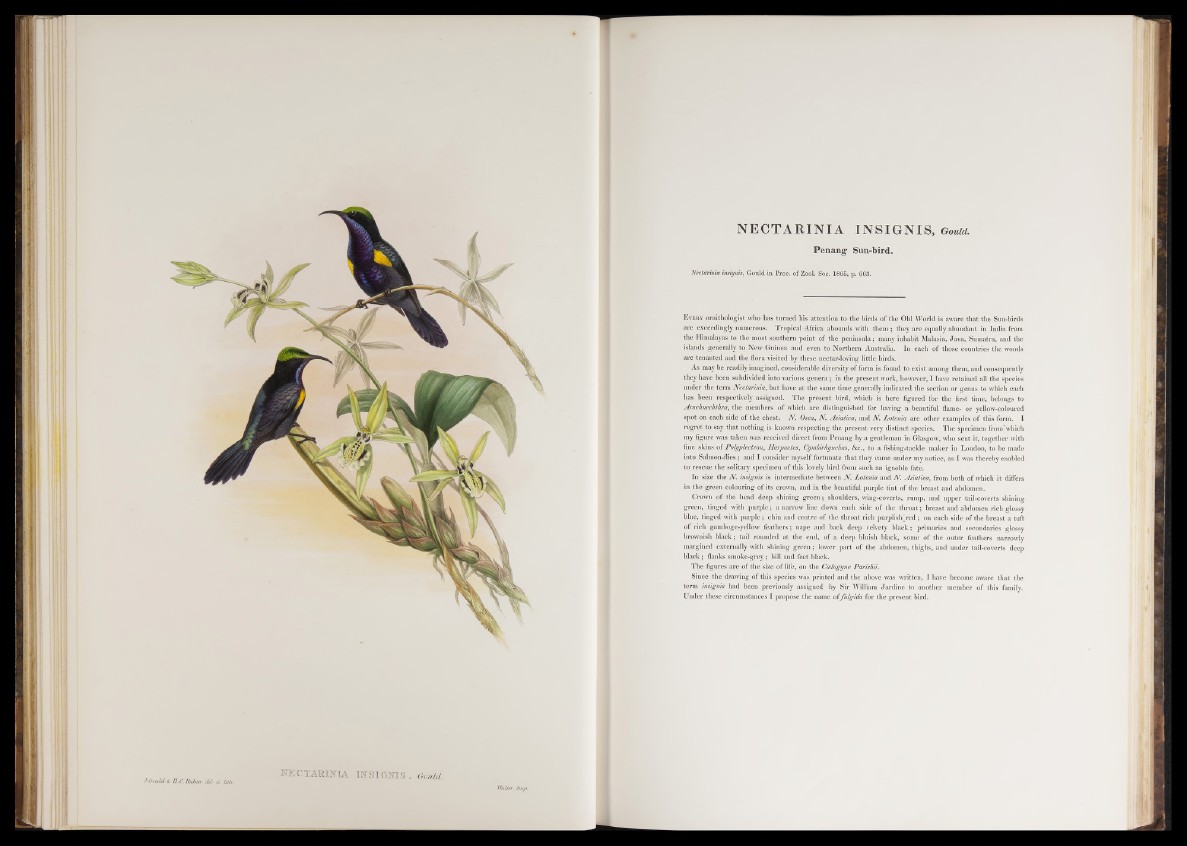
J.C ro id d sir, H .C .B ic h ta -, deL tU lith j. n r a & r a s . goum.
N E C T A R I N I A I N S I G N I S , G o u l d .
Penang Sun-bird.
Nectarinia insignia, Gould in Proc. of Zool. Soc. 1865, p. 663.
E very ornithologist who has turned his attention to the birds of the Old World is aware that the Sun-birds
are exceedingly numerous. Tropical Africa abounds with them ; they are equally abundant in India from
the Himalayas to the most southern point of the peninsula; many inhabit Malasia, Java, Sumatra, and the
islands generally to New Guinea and even to Northern Australia. In each of those countries the woods
are tenanted and the flora visited by these nectar-loving little birds.
As may be readily imagined, considerable diversity of form is found to exist among them, and consequently
they have been subdivided into various gen era; in the present work, however, I have retained all the species
under the term Nectarinia, but have a t the same time generally indicated the section or genus to which each
has been respectively assigned. The present bird, which is here figured for the first time, belongs to
Arachnechthra, the members of which are distinguished for having a beautiful flame- o r yellow-coloured
spot on each side o f the chest. N . Osea, N . Asiatica, and N . Lotenia are other examples of this form. I
regret to say that nothing is known respecting the present very distinct species. The specimen fromrwhich
my figure was taken was received direct from Penang by a gentleman in Glasgow, who sent it, together with
fine skins of Polyplectron, Harpactes, Cymbirhynchus, &c., to a fishing-tackle maker in London, to be made
into Salmon-flies; and I consider myself fortunate that they came under my notice, as I was thereby enabled
to rescue the solitary specimen of this lovely bird from such an ignoble fate.
In size the N . insignis is intermediate between N . Lotenia and N . Asiatica, from both o f which it differs
in the green colouring of its crown, and in the beautiful purple tint o f the breast and abdomen.
Crown of the head deep shining g reen ; shoulders, wing-coverts, rump, and upper tail-coverts shining
green, tinged with pu rp le; a narrow line down each side o f the th ro a t; breast and abdomen rich glossy
blue, tinged with p u rp le ; chin and centre o f the throat rich purplish’red ; on each side of the breast a tuft
of rich gamboge-yellow feathers; nape and back deep velvety black; primaries and secondaries glossy
brownish black; tail rounded a t the end, of a deep bluish black, some of the outer feathers narrowly
margined externally with shining g ree n ; lower part o f the abdomen, thighs, and under tail-coverts deep
black; flanks smoke-grey; bill and feet black.
The figures are of the size o f life, on the Ccelogyne Parishii.
Since the drawing of this species was printed and the above was written, I have become aware that the
term insignis had been previously assigned by Sir William Jardine to another member o f this family.
Under these circumstances I propose the name offulgida for the present bird.